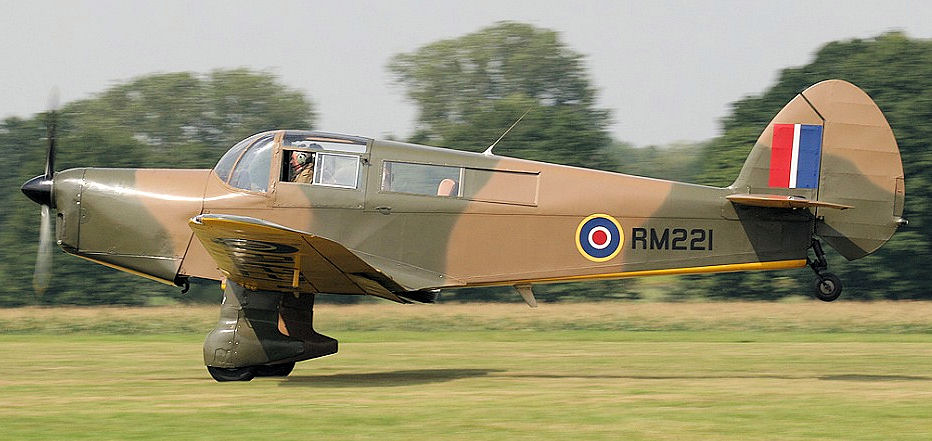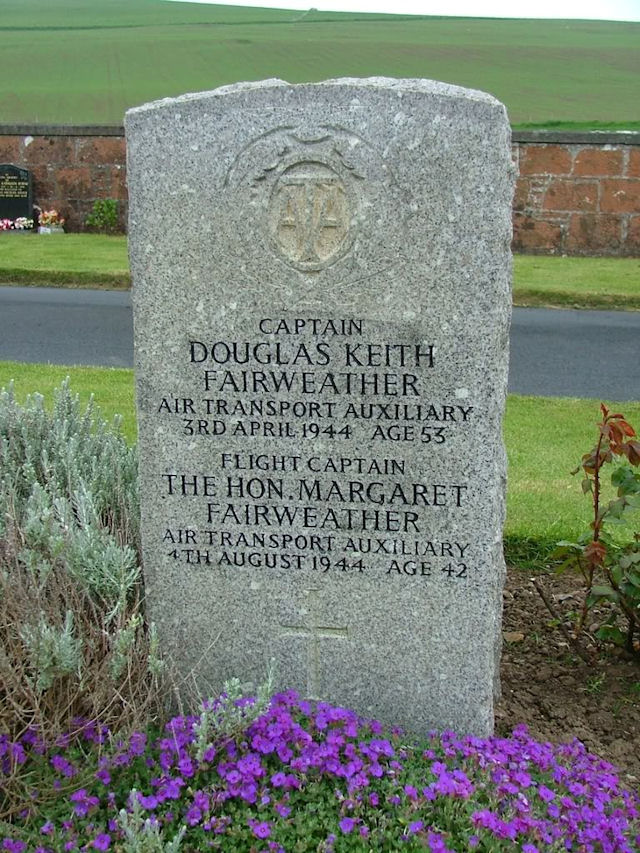4-engine (Class 5) pilot Mrs King-Farlow from 1925 to 1936; Mrs Fairweather from 1938. The eldest daughter of Lord Walter and Lady Hilda Runciman. Her brother Walter (co-Director, with Connie Leathart (q.v.), of Cramlington Aircraft, First Director-General of BOAC, Commodore of the Royal Yacht Squadron, OBE, etc, etc) became the 2nd Viscount Runciman of Doxford, and her sister Katherine ('Kitty') was adjutant for the Women's Section of the ATA from March 1941. I sometimes feel that Margie gets a bad press; she was, apparently, quiet and rather withdrawn, (nicknamed 'Mrs Cold Front') and, in photos, always seems to have that far-away look in her (green, btw) eyes. But, her ability, and her devotion to duty and to her friends, were never in doubt. She got her RAeC certificate in 1937. In fact, she acquired her first aeroplane from her brother Walter; a 1931-reg D.H. Puss Moth G-ABLG, which he had flown in two King's Cup races. She had married Roderick Nettleton King-Farlow in July 1925. Their daughter Ann was born in 1931, but they divorced in 1936, and she then married Douglas Keith Fairweather in March 1938. He was a businessman from Glasgow, and her complete opposite - outgoing, irreverent, and very eccentric. Margie then sold her aeroplane, and she and Douglas re-registered his Puss Moth G-ABYP in their joint names. Later they also bought a Leopard Moth, G-ACXH. She had a horrible experience in 1939 when her friend, Dr. Elizabeth Cook, was killed by walking into the propeller of the aeroplane Margaret was about to pilot; they were going to fly to Paris for a holiday, and the plane was standing with the engine ticking over.
So, prior to WWII she was one of the most experienced women pilots in the country, with 1,050 hours of civilian flying, and (from late 1937) was an instructor with the Scottish Flying Club. She had flown Miles Whitney Straights, D.H. Moths, Puss Moths, Tiger Moths, Fox Moths, Leopard Moths, Hornet Moths, Dart Kitten, Taylor Cub, Potez, and Percival Vega Gull, in Belgium, Holland, Germany, Sweden, Denmark, Hungary, Czechoslovakia, France Switzerland and Austria.
Not surprisingly then, she was one of the 'First Eight' Women ATA pilots at Hatfield, starting in January 1940. Her training went well: "The handling characteristics of the Service trainer were entirely novel to Mrs. Fairweather, but having once mastered the take-off, she had no further difficulty, and is now able to fly both Master and Oxford satisfactorily. Her cockpit drill is excellent'" Douglas also joined the ATA as a pilot. He was devoted to Margie; as Lettice Curtis says in Forgotten Pilots: he was once heard to say, "I love Margie, better than any dog I ever had," and then more thoughtfully, "or even a pig or a cat."
On the 3rd March 1941 she was one of the four women especially praised by Pauline Gower: "The following pilots during the past year have been outstanding from the point of view of hard work and have set an example to others:- Mrs M Wilberforce [exceptional devotion to duty], Miss M Cunnison [great devotion to duty], Hon Mrs M Fairweather [has shown great devotion to duty, and worked hard and conscientiously as a taxi pilot], and Miss J Hughes [has shown devotion to duty]." [Mona Friedlander, Rosemary Rees, Lois Butler, Gabrielle Patterson and Winifred Crossley also get a mention [they have 'worked hard and conscientiously'], and Pauline added that "had Miss Amy Johnson still been with us [she had died on the 5th January], her name would have been particularly mentioned".] In May 1941 Margie requested extra leave: "Dear Commander Whitehurst, As you know I have a daughter of twelve years of age. She is at boarding school during the term time, but for half of the period of each holidays I am responsible for her care. With the assistance of my family I have managed up to now fairly well without interfering with my work, but I now, owing to reasons of health and occupation I can no longer count on this help and paid help is almost impossible to come by. In these circumstances I am writing to enquire whether ATA would consider granting me an extra week's leave in the summer, and a fortnight's extra leave at both Xmas and Easter, it being understood that any leave so granted would be without pay." The request was granted, and Margie and Douglas took Ann for a holiday in a small farmhouse in Western Scotland [where they acquired a baby goat, which Douglas later took with him on at least one ferry flight.] She and Douglas were both posted to Prestwick (4b Ferry Pool, Northern Area) in November 1941. On the 14th December, she wrote to Pauline Gower: "Sunday, Dear Pauline, I was hampered in talking to you the other day by the crowd around the telephone, amongst which were persons about whom I wanted to speak. I am not sure we can make good use of the lady in question at this moment. We need a second ground person in this office but he or she must, as well as doing adjutant duties, be a good shorthand typist. Unless we combine the jobs there isn't sufficient to do. The lady's counterpart is doing 'ops' just now with only moderate success. It would be a pity to get her up here if that falls through. She is too 'choosy' for our mixed bag of aeroplanes to come only as a pilot. I am sorry we raised her hopes so high. Perhaps in a week or two the matter might be reconsidered if you have no other plans in view for her. I have at last caught a Wellington for myself. I flew it with great pleasure from Prestwick to Sherburne today and am now here on my way back with a Hurricane. I found it very like a big Anson, & I can see no reason why any of the normally hefty of us should find them too heavy. It was tough today & at slow speeds as when coming in to land you have to heave and push but forewarned there is no difficulty. I wonder who of the others have had one and what they think. We have had a tragedy already in no. 4b FPP. A charming American called Wiley who was posted to us left Speke on Wednesday afternoon & has not been heard of since. It is strange (or perhaps just a matter of psychology) how it always seems to be the nice ones that go and the toughs who remain. Living in the … hotel as we are doing amongst all the over-night ATA one gets a bit of a … about humanity. I was almost pleased to see Mary H[unter], & Veronica [Volkersz] yesterday by contrast! Douglas is in his element entertaining his visiting pilots; clearly our post war job must be public house proprietors with Douglas as 'mine host'. Please make Kitty write to me again soon. I loved getting your letters. When are you coming to inspect me? I wish you would. I would love to have a talk. Are you likely to be at W[hite] W[altham] without warning if I cadge an aeroplane to that point? with love, Margie." She was promoted to Flight Captain in February 1942, in charge of the Women's Flight at Prestwick. Her Commanding Officer said that she was a "very reliable and steady ferry pilot ... she has been a very real help to me." Shortly after that, she had her spat with Irene Arckless (q.v.) She also had an 'incident' on the 24th March 1943 - flying a Halifax (she was one of only 11 women cleared for 4-engine aircraft), the bolts securing an engine cowling broke away and fouled a propeller. Luckily, she was uninjured. However, she was in big trouble in May 1943 - some Flight Captain or other (I can't make out the signature) wrote to Pauline: "It is observed that F/Capt Mrs Fairweather is not complying with Standing Orders re. her hair. Also, this pilot still persists in wearing grey coloured stockings, whereas black is the order. Will you please be good enough to point out to this pilot that the Commanding Officer's Instructions in regard to 'Dress Regulations' must be complied with." There is a scribbled note "Is anything ever done?", but, indeed, no sign of anything else happening ... And then, on the 14th September 1943, (so, when Margie was nearly 42), and rather out of the blue , came this: "Flight Captain Mrs Fairweather is pregnant and I recommend that her contract is terminated with three months' pay in lieu of notice." [The ATA policy was that women who became pregnant would have their contracts terminated, to give them 3 months salary. However, Pauline soon discovered that Margie was "not interested in the financial aspect, but would rather have her contract suspended" and added,"I think we might well meet her wishes in this case."] So, her contract was suspended, and she duly returned back to work on the 15th June 1944. By then, sadly, Douglas was dead; he and ATA Nurse Kathleen Kershaw had crashed in the Irish Sea, on a mercy flight to Prestwick. Douglas and Margie's daughter Elizabeth was born a few days after his death. And then Margie herself died in another crash soon after, on the 4th August 1944. It happened on a communications flight in Percival Proctor III LZ801; the engine 'faded out', she force-landed in a field near Wrexham, but hadn't seen a ditch at the end of it. The aircraft went nose first into the ditch.
She, and her sister Kitty suffering from severe fractures to her right leg, were taken to Chester Royal Infirmary. Margie had serious head injuries; the third person on board, Lewis Kendrick, had minor abrasions. Margie died at 11 p.m., without regaining consciousness. The technical investigation showed that the vent pipe of the port fuel tank was completely blocked by a film of dope, causing the tank to collapse. "In these circumstances the petrol gauge is likely to have indicated that the tank still contained fuel, when in fact it was dry." Blame was heaped on everyone involved in ensuring the aircraft had been fit to fly: The Chief Engineer, and the Engineers in Charge at White Waltham, for failing to ensure that it had been serviced properly; the Officer-in-Charge Air Movements Bay; the Engineering Inspector, for failing to ensure that the fitters were competent, and the two fitters who failed to notice the blocked vent. The report recommended that procedures were changed, and Proctors modified, to prevent it happening again. The cause of death was 'extensive skull fracture'; I've not come across any reference to Margie's spectacles shattering and contributing to her death, although this has been suggested recently. She is buried, together with Douglas, in Dunure Cemetery, South Ayrshire. Near Prestwick.
28th August 1944 Dear Mr d'Erlanger, You will I hope forgive me for being slow to thank you for your kind letter & for what you say of Margaret's work, and I would like especially to thank you for all the kindness and consideration shown to my daughter Ruth & for all the arrangements made for the funeral which we could not have wished otherwise. I would be grateful if you could also pass on our thanks to whoever in the RAF was responsible for allowing her to lie in that little war cemetery beside Douglas. We very greatly valued the kindness that prompted that decision. I am afraid it will be a long time before Kitty is up & about, but we are glad to have no real anxiety about her. Hilda Runciman Margie's loss was "a great blow to ATA, for she was not only one of our best women pilots, but in her modest and enthusiastic manner set an almost unequalled example of unselfish devotion to duty." Oxford DNB : "Fairweather [née Runciman], Margaret (1901–1944), airwoman, was born at West Denton Hall, near Newcastle upon Tyne, on 23 September 1901, the second in a family of two sons and three daughters of Walter Runciman, first Viscount Runciman (1870–1949), and his wife, Hilda Stevenson (1869–1956) [see Runciman, Hilda]. Margie, as she was always known, was educated initially at home together with her younger brother Steven (later Sir Steven Runciman) by a governess who taught them Greek and Latin at an early age. She then attended a number of educational institutions including The Mount, a Quaker school in York, and Notting Hill high school, from where she went to Girton College, Cambridge. After a year she dropped out of Girton to study singing in Paris, though she never performed professionally. She married Roderick Sydney Nettleton King-Farlow (1900–1988), the son of Sir Sydney Charles Nettleton King-Farlow, at St Margaret's, Westminster, on 15 July 1925. A daughter was born in 1931. The marriage ended in divorce in 1936. In the autumn of 1936 Margie learned to fly at Newcastle Aero Club and was issued with her aviator's certificate (licence no. 14687) by the Royal Aero Club on 13 January 1937. She was planning to fly solo to Australia but changed her mind when she met a fellow pilot, Douglas Keith Fairweather (1891–1944), son of Sir Walter Fairweather. They were married on 28 March 1938. In that year Lord Runciman was sent on the ill-fated mission to Prague to mediate between the German and Czech governments. Fairweather flew out herself to visit him. During a European tour that same year she and Douglas, under the guise of tourists, photographed unrecorded German airfields. She also sent back letters to her brother Steven which seemingly contained only trivial domestic details. On her return, however, she decoded these to recover intelligence data. With the threat of war looming, in October 1938 the Civil Air Guard scheme was inaugurated to provide subsidized training of pilots through the civil flying clubs. As experienced pilots, Margie and her husband became instructors at Renfrew. Douglas Fairweather was one of the first to sign contracts with the British Overseas Airways Corporation (BOAC) for service with the AirTransportAuxiliary (ATA) in September 1939. Many women, qualified flying instructors with considerable flying experience, volunteered to serve with the ATA. However, the pilots enrolled by BOAC under the ATA scheme were employed in RAF ferry pilots' pools and the RAF would not agree to the employment of women in their ferry pools. This problem was solved in December 1939 when Pauline Gower (who became commandant of the women's ATA) was informed that a small pool of eight women based at Hatfield could be formed to ferry Tiger Moths to stored reserves. With over 1000 flying hours, Margaret Fairweather was one of that select band who signed contracts with the ATA on 1 January 1940. This departure from tradition caused a furore in a world in which professional women were still a novelty. Press and newsreel gave full publicity to the event and the so-called ‘ATA girls’ were under constant scrutiny. However, ferrying Tiger Moths from Hatfield to storage reserves, some as far away as Kinloss, Perth, and Lossiemouth, and returning by overnight train, often with no sleeper in midwinter, was not the glamorous occupation some imagined. In July 1941 ATA women pilots were cleared to fly operational aircraft and Margaret Fairweather was one of the first four chosen to do practice landings in a Hurricane. These four carried a burden of responsibility as the future of all women pilots in the ATA depended on them. Meanwhile Douglas Fairweather was joint commanding officer at Prestwick. In 1942 he was posted to no. 1 ferry pool, White Waltham, to take charge of the air movements flight. Margie was then posted to join him. For the rest of her time there she was engaged in communication duties and it was on one such assignment that she met her death—the only one not to survive among the original eight who served from the very beginning. Gradually more operational types of plane were being flown by women and the progression was made from single engine to twin aircraft to advanced twin, and eventually eleven women pilots were qualified to fly four-engined aircraft. Fairweather was one of the eleven. She was considered by her fellow pilots to be one of the most intelligent and able, though rather quiet and self-effacing. In fact, according to her daughter, her nickname was Mrs Cold Front. On 3 April 1944 Douglas Fairweather volunteered to go to Prestwick to collect an ambulance case requiring special treatment. In appalling weather, somewhere over the Irish Sea, the Anson came down and both he and the nurse travelling with him were lost. Margie gave birth to their daughter Elizabeth a few days later. Margie returned to flying only to be killed herself four months later. She was piloting a Proctor to Scotland on 4 August 1944 with two passengers on board when the engine failed near Malpas, Cheshire. All three were taken to Chester Royal Infirmary where Fairweather died soon afterwards. Her passengers were her sister, the Hon. Kitty Farrer, adjutant of the ATA, and Louis Kendrick of the Ministry of Aircraft Production. They recovered, escaping with injuries. Douglas Fairweather's body was washed up on the Ayrshire coast. Margaret Fairweather and he were both buried in the small churchyard of Dunure, Ayrshire." |

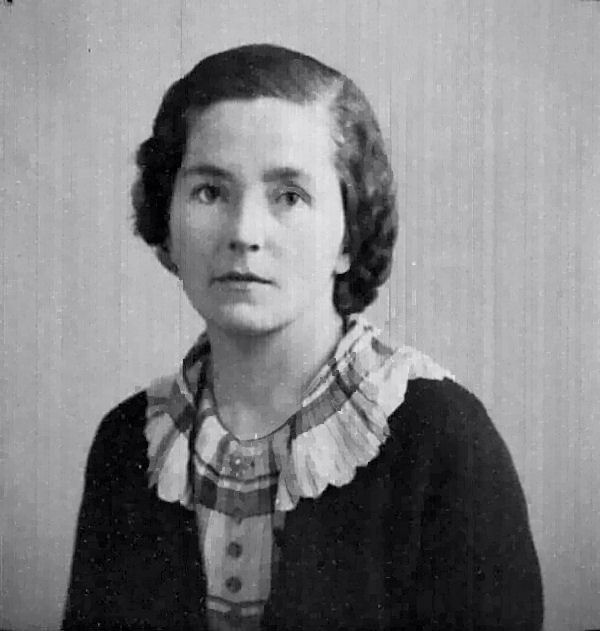 RAeC 1931
RAeC 1931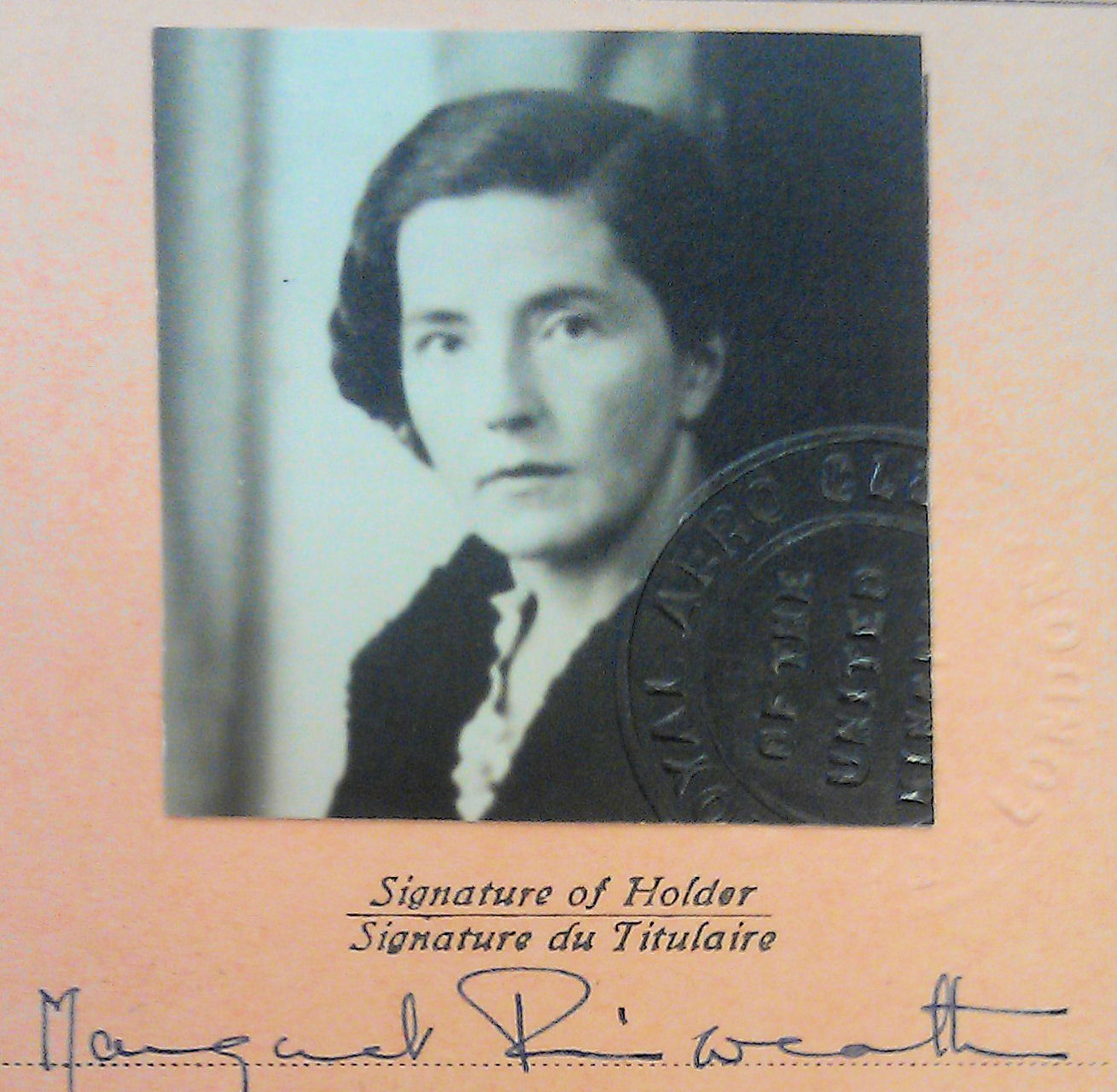 FAI 1939
FAI 1939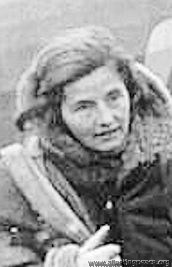
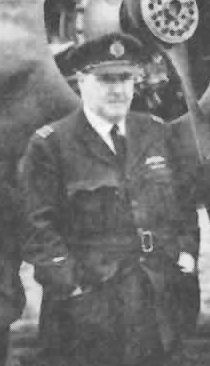 [For more about Douglas, I can recommend 'Brief Glory - the Story of the ATA']
[For more about Douglas, I can recommend 'Brief Glory - the Story of the ATA']